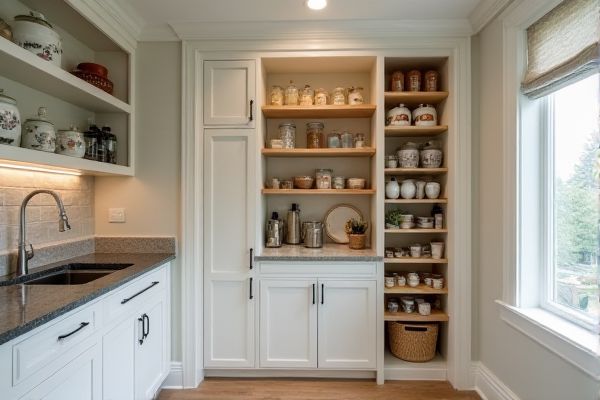
Open shelving in pantries offers easy visibility and accessibility, making it ideal for frequently used items and creating an airy, spacious feel. Closed cabinetry protects your pantry contents from dust and offers a cleaner, more organized look; explore the article to decide which option best suits your kitchen needs.
Table of Comparison
| Feature | Open Shelving | Closed Cabinetry |
|---|---|---|
| Accessibility | Easy and quick access to items | Items hidden behind doors; requires opening |
| Visibility | Full visibility of pantry contents | Contents concealed, promoting a clean look |
| Organization | Requires consistent neatness for aesthetics | Easier to hide clutter and organize discreetly |
| Cleaning | Dust and debris accumulate more easily | Less exposure; easier to maintain cleanliness |
| Design Style | Casual, modern, and airy feel | Traditional, sleek, and polished appearance |
| Cost | Typically lower installation and material cost | Generally higher cost due to doors and hardware |
| Space Utilization | Maximizes storage space by using full shelf height | May have wasted space behind doors or deeper shelves |
Introduction to Pantry Storage Options
Open shelving in pantry storage offers easy visibility and quick access to food items, making organization simple and efficient. Closed cabinetry protects your pantry contents from dust, pests, and light exposure, preserving freshness and creating a cleaner look. Choosing between open and closed storage depends on your kitchen style, maintenance preferences, and how you prioritize accessibility versus protection for your food supplies.
What is Open Shelving in a Pantry?
Open shelving in a pantry refers to storage units without doors or covers, allowing easy access and visibility to food items and kitchen essentials. This design enhances organization by encouraging neat arrangement and quick inventory checks, while also adding a modern, airy aesthetic to the space. Popular materials for open shelving include wood, metal, and glass, each contributing to durability and style in pantry design.
Understanding Closed Cabinetry for Pantries
Closed cabinetry in pantries provides a sleek, organized appearance by concealing food items and kitchen supplies behind solid doors, protecting contents from dust and light. These cabinets offer adjustable shelving options, maximizing storage efficiency and allowing you to customize your pantry based on your specific needs. Your pantry will maintain a tidy, uniform look, enhancing overall kitchen aesthetics while improving hygiene and ease of maintenance.
Aesthetic Appeal: Open vs. Closed Designs
Open shelving in a pantry creates an airy, visually accessible aesthetic that showcases your kitchenware and encourages organization while adding a modern, minimalist touch. Closed cabinetry offers a streamlined, uniform appearance, concealing clutter and protecting items from dust, lending a polished and timeless look to your space. Choosing between open shelving and closed cabinetry depends on whether you prioritize display and accessibility or a clean, discreet storage solution for your pantry.
Organization and Accessibility Considerations
Open shelving in pantries enhances organization by providing immediate visibility of items, which simplifies locating and retrieving ingredients for quick access. Closed cabinetry offers concealed storage that protects pantry goods from dust and light, helping maintain freshness while creating a cleaner, uncluttered appearance. Choosing between open shelving and closed cabinetry depends on balancing easy accessibility with the desire for controlled storage and visual tidiness in kitchen organization.
Maintenance and Cleaning Differences
Open shelving in pantries requires frequent dusting and cleaning, as exposed surfaces accumulate dust, grease, and crumbs more quickly than closed cabinetry. Closed cabinetry protects pantry contents from dirt and pests, reducing the frequency of cleaning while offering easier maintenance by concealing stains and spills within enclosed spaces. Materials like glass or solid wood for doors can further simplify maintenance by preventing contamination and allowing for surface wipes without disturbing stored items.
Space Optimization and Storage Capacity
Open shelving in pantries maximizes space optimization by allowing easy access and visibility of items, making it ideal for frequently used goods and smaller kitchens. Closed cabinetry offers superior storage capacity by utilizing enclosed compartments that protect contents from dust and provide customizable options such as adjustable shelves or pull-out drawers. Selecting between the two depends on balancing the need for accessible organization versus maximizing concealed storage space.
Impact on Pantry Safety and Food Preservation
Open shelving in pantries improves visibility and accessibility but exposes food items to dust, pests, and fluctuating temperatures, potentially compromising food preservation and safety. Closed cabinetry offers a controlled environment by protecting food from contaminants and moisture, reducing the risk of spoilage and extending shelf life. Choosing closed cabinetry enhances pantry safety and maintains optimal food quality through better environmental control.
Cost Comparison: Open Shelving vs. Closed Cabinets
Open shelving in pantries generally costs less due to lower material and installation expenses, making it a budget-friendly option for homeowners. Closed cabinetry requires additional components such as doors, hinges, and hardware, which increase the overall cost by 20-40% compared to open shelving. Maintenance and longevity considerations may also impact value, as closed cabinets protect contents from dust and pests, potentially reducing replacement expenses over time.
Choosing the Best Option for Your Kitchen Pantry
Open shelving in your kitchen pantry offers easy access and visibility for frequently used items, making organization simpler and adding a sense of spaciousness. Closed cabinetry provides protection from dust and pests, preserving the freshness of food and maintaining a clutter-free appearance. Your choice depends on balancing aesthetic preferences with practical needs, such as maintenance and storage requirements.
 homyna.com
homyna.com